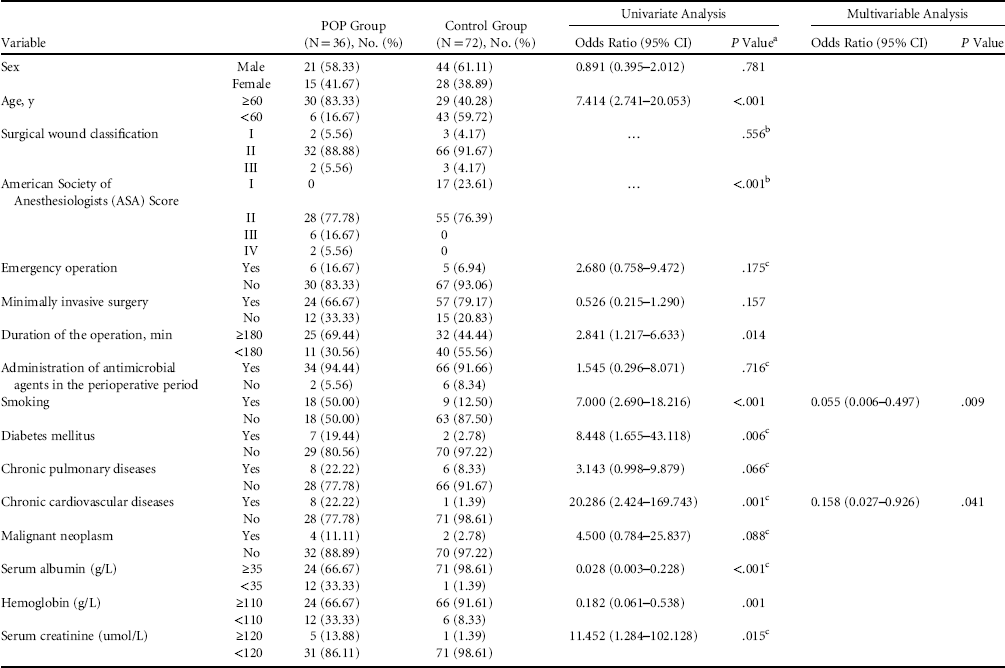To the Editor—Postoperative pneumonia (POP) is defined as hospital-acquired or ventilator-associated pneumonia in postsurgical patients; it is among the most common complications among postsurgical patients, leading to increased morbidity, length of hospital stay, and costs.Reference Kollef 1 , Reference Wren, Martin, Yoon and Bech 2 Elucidating the risk factors for POP would help reduce the incidence of this complication; however, few studies have been published concerning POP with abdominal operations in Chinese hospitals.
To determine the incidence of, pathogens implicated in, and risk factors for POP in abdominal operations in China, we conducted a research in The Second Affiliated People’s Hospital of Fujian University of Traditional Chinese Medicine, a tertiary-care teaching hospital in southeastern China. All patients who received abdominal operations between January 1, 2015, and December 31, 2015, in this hospital were included in the study. The demographic data and medical records including imaging, and laboratory tests were reviewed, and healthcare-associated infections were monitored as usual. Pneumonia was identified using the 2015 US Centers for Disease Control and Prevention (CDC) criteria for a pneumonia event. 3
Among the 618 patients who received abdominal operations, 36 patients (5.83%) developed POP. The POP incidence rates differed among abdominal surgery types as follows: gastric, 11 of 56 (19.64%); hepatic, 4 of 27 (14.81%); colorectal, 16 of 127 (12.60%); biliary tract, 4 of 80 (5.00%); appendix, 1 of 156 (0.64%); and inguinal hernia surgery, 0 of 172 (P < .001). Lower respiratory tract specimens from 30 POP patients were sent to the microbiology laboratory for pathogen culture, and 12 samples were positive for bacterial growth. The following pathogens were isolated: Klebsiella pneumoniae (4 strains), Pseudomonas aeruginosa (2 strains), Escherichia coli (2 strains), Staphylococcus aureus (2 strains), and Candida albicans (2 strains).
To determine the risk factors for POP, univariate analysis and multivariable analysis (logistic regression analysis) were used. Patients who developed POP after abdominal operations were included in the POP group. For each POP patient, 2 controls were randomly selected from patients who did not acquire pneumonia before and after abdominal operations and did not develop other healthcare-associated infections during this hospitalization. As shown in Table 1, univariate analysis revealed that POP patients had higher rates of smoking, diabetes mellitus, chronic pulmonary disease, chronic cardiovascular disease; higher levels of serum creatinine; higher American Society of Anesthesiologists (ASA) scores; lower levels of serum albumin and hemoglobin; and longer durations of surgery than control patients. Multivariable analysis demonstrated that smoking and chronic cardiovascular disease were independent risk factors for POP.
TABLE 1 Possible Risk Factors of Postoperative Pneumonia (POP)

a χ2 test unless otherwise specified.
b Mann-Whitney-Wilcoxon Test.
c Fisher exact test.
The POP incidence has been reported to be between 0.78% and 40%, making it the third most common infection in patients after an operation, with a mortality rate between 30% and 40%.Reference Wren, Martin, Yoon and Bech 2 , Reference Markar, Walsh, Griffin, Khandanpour, Tang and Boyle 4 The present study shows that the incidence of POP is not considered low in patients undergoing abdominal operations, especially in gastric, hepatic, colorectal, or biliary tract surgeries. Gastric juice reflux, aspiration, and/or more serious injury during the procedure might be reasons for this phenomenon. Pathogens causing POP are ubiquitous in healthcare settings, which are similar to those responsible for other hospital-acquired pneumonia.
Several factors have been correlated with POP after abdominal operations; therefore, it is likely that much could be done perioperatively to reduce the frequency of the complication. Most measures are the same strategies used for the prevention of surgical site infections,Reference Berrios-Torres, Umscheid and Bratzler 5 including the management of underlying disease (especially chronic cardiovascular disease, diabetes mellitus, chronic pulmonary disease), improving the patient’s nutritional status, cessation of smoking, improving operation skill, and reducing the duration of surgery. Focusing on these measures in these patients could reduce their risk for POP.
In conclusion, the POP incidence is not low in abdominal operations, and the complication is more common in patients with chronic cardiovascular disease or in habit of smoking, and its major pathogens are gram negative bacteria.
ACKNOWLEDGMENTS
Financial support: This work was supported by the Xiangya Clinical Big Data Project (No. 40).
Potential conflicts of interest: All authors report no conflicts of interest relevant to this article.



